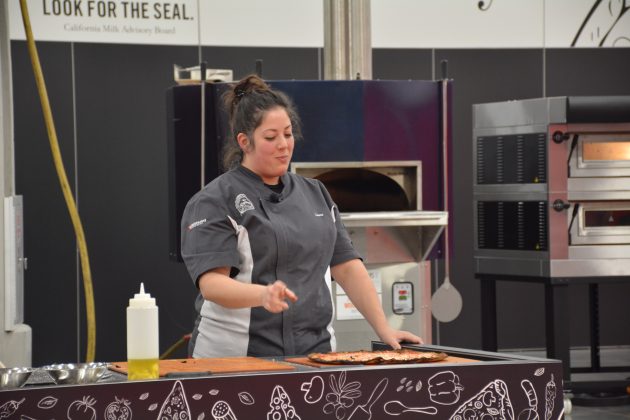
Pizza Demo: Tavern-Style
By Canadian Pizza
Features News In the Kitchen Techniques Trends demonstration tavern-style pizzaLaura Meyer’s tavern-style pizza demo was one of many excellent demos at Vegas Expo
 Chef Laura Meyer defines tavern-style as “crackerthin” pizza that can vary widely by region. Photo: Canadian Pizza
Chef Laura Meyer defines tavern-style as “crackerthin” pizza that can vary widely by region. Photo: Canadian Pizza The International Pizza Expo in Las Vegas, true to form, delivered a high standard of exciting education sessions, competitions, demonstrations and products to pizzeria operators.
One highlight was a popular demo by Laura Meyer: How to Make Tavern-Style Pizza.
The talented and busy Laura Meyer of Tony Gemignani’s International School of Pizza demonstrated her method for making tavern-style pizza. Meyer defines the style as “cracker-thin” pizza that can vary widely by region. Tavern-style calls for unleavened doughs and not a lot of aeration. Ideally it should be served immediately after baking to retain the crispness and heat.
Meyer demonstrated two methods: parbaked for maximum crispiness and cooked from raw with sauce and cheese. She made two regional styles: Chicago cornmeal-style (saltine cracker texture) and St. Louise style (so crispy it shatters).
Method 1: Parbaked
Chicago cornmeal-style (Ritz-cracker texture) is an example of a parbaked tavern-style crust. She uses about five per cent cornmeal, it has low fat content. She uses an all-purpose flour base, her preference being an extremely low-protein base (about 11 per cent).
With no space for a sheeter in the pizzeria, Meyer makes crusts in advance by hand and they sit on a shelf until ready to use for that day’s service. She uses a 13-ounce dough ball stretched to 16 inches and coated in medium-grind cornmeal. It’s a highly efficient handmade assembly line.
A docker helps de-gas or reduce bubbles in the dough. Meyer warned chefs not to perforate the dough. She suggested aiming for slight coloration on the first bake, being careful not to let the dough dry out.
The bottom of the oven is set at seven per cent to “crisp the dough.” The dough bubbles a bit, then deflates. The parbaked crusts are then nested inside a box where they grow up instead of out. Doughs should be stretched a little larger than the screen.
The second bake is two minutes long. Doughs then sit stacked for up for eight to nine hours of service. This helps them retain moisture.
The award-winning pizza chef and veteran instructor had a few cautions: These crusts do not hold a chunky sauce. Instead, she recommends a thicker purée, which she said is a good way to sweeten the pizza without adding sugar. For a cheese pizza, lower-moisture cheeses seem to work better and the second bake can be shorter. Raw items need a longer bake. Pizzas may need to be moved around in a wood-fired oven, which is not what she typically teaches. “Not all parbakes come out equal,” she said. “These are often split-second decisions.”
Method 2: Cooked from raw
Meyer also made a St. Louis-style pizza, which she calls “a very humbling pie.” Tricky to make, it ideally features no more than five ingredients. “We do say no sometimes,” Meyer said with a smile referring to customer requests for extra toppings.
She uses a nine-ounce dough ball stretch to 16 inches and docks the dough. There is not a lot of moisture – it dries out quickly.
This regional style is distinctive and not for every taste, she said. It often features a white processed cheese called Provel, which is a combination of cheddar, Swiss and provolone. For this pie, it’s best to use a low-moisture cheese with a low melting point and a high flow rate, and a very sweet sauce.
She parbakes longer the first time and there are little things she does to accommodate toppings. “You need to cook the crust a little longer to get the browning because there is no sugar,” she said.
It’s basically a six-minute pie, said Meyer, who likes to pitch tavern-style as an app for a group of guests to increase your sales ticket.
This is just one of many fascinating demonstrations and learning sessions organized by the folks at the International Pizza Expo, held annually in March in Las Vegas. The next Expo is set for March 28-30, 2023.
Print this page